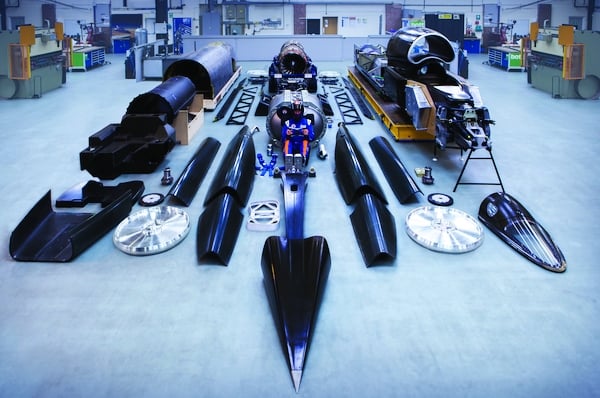East Wintergarden in Canary Wharf was the venue for the grand reveal of Bloodhound SSC, the world’s fastest and most advanced vehicle that is the product of eight years of research, design and manufacturing involving over 350 companies and universities.
The car is the star of a free, two-day exhibition that has 8,000 confirmed visitor registrations who will be among the first to see the completed 13.5m streamliner, which uses jet and rocket motors to produce c.135,000 thrust hp to make Bloodhound the worlds’ powerful land vehicle.

The Bloodhound Project, the team behind the vehicle, say Bloodhound SSC is being shown in record attempt configuration, with its 2m high tail fin in place for the first time.
Carbon fibre panels have been partially removed on one side in order to show the technology inside the car, including the Rolls-Royce EJ200 jet engine and supercharged Jaguar V8 engine used to pump oxidizer into the Nammo rocket.
CLICK HERE TO ACCESS ALL OF THE ENGINEER'S BLOODHOUND SSC COVERAGE
Visitors this weekend will be invited to look inside the finished cockpit, which is a complex monocoque made from multiple layers of carbon fibre that houses a sophisticated digital dashboard, designed by the driver Andy Green, as well as manual back-ups for the major controls.
The Bloodhound team explained that this level of redundancy would help reach its goal of 1,000mph safely, which is a key element of the vehicle’s design and why the vehicle has three separate braking systems, seven fire extinguishers and 500 sensors so engineers will know exactly how it is performing during each high speed run.
Castrol is providing a number of lubricants including a specially blended engine oil, strengthened with their Titanium Fluid Strength Technology.
Bespoke Rolex instruments provide another layer of redundancy: should the digital read-outs fail, Green will use these clocks to time the release of the car’s parachutes and when to apply the wheel brakes. If he brings them in too soon, at speeds above 250mph, for example, they could burst into flames.
The car has been created by a team of Formula 1 and aerospace experts with assistance from the Army’s Royal Electrical and Mechanical Engineers and technicians from the RAFs 71 Squadron who built the tail fin.
https://www.youtube.com/watch?v=4H3et2ZSea0
Bloodhound SSC also has 12 cameras built into it, including two inside the cockpit that will be live for the first time during the public show.
When the team is racing for its first record next year in South Africa, audiences will experience the same view as Green and see the same information. They will know how the car is balanced, the temperatures in the engines, the speed through the measured mile.
Sharing the experience in this way, and all the data coming from the car, is a core principle of The Bloodhound Project and central to its mission of inspiring a future generation about science, technology, engineering and mathematics.
“Public interest in The Project is incredible and thanks to the generous support of our partners we are delighted to able to bring Bloodhound SSC to London and put it on show,” said project director Richard Noble in a statement. “With the car now built and the track in South Africa prepared our focus is on racing in 2016. That part of the adventure starts with runway tests at Newquay Aerohub next Easter.”
https://www.youtube.com/watch?v=282cTJoSlPM




Project to investigate hybrid approach to titanium manufacturing
What is this a hybrid of? Superplastic forming tends to be performed slowly as otherwise the behaviour is the hot creep that typifies hot...